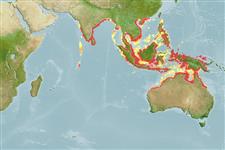Common names from other countries
>
Eupercaria/misc (Various families in series Eupercaria) >
Sciaenidae (Drums or croakers)
Etymology: Nibea: Greek, niba, nipsis = to wash.
More on author: Lacepède.
Environment: milieu / climate zone / depth range / distribution range
Ecología
marino; agua dulce; salobre demersal; anfidromo; rango de profundidad 1 - 40 m. Tropical; 22°N - 23°S, 72°E - 149°E (Ref. 57000)
Indo-West Pacific: coasts of India and Sri Lanka eastwards extending to Queensland, Australia and New Guinea and north to Viet Nam (Ref. 3490). Found in the lower Mekong basin (Ref. 36667).
Tamaño / Peso / Age
Maturity: Lm ? range ? - ? cm
Max length : 60.0 cm SL macho / no sexado; (Ref. 9772); common length : 40.0 cm SL macho / no sexado; (Ref. 9772)
Espinas dorsales (total) : 10 - 11; Radios blandos dorsales (total) : 27 - 33; Espinas anales: 2; Radios blandos anales: 7. Snout rounded, but not swollen or projecting; upper jaw length 38-44 % of head length, lower jaw length 44-53 % of head length. First pair of mental pores close together, united by a crescent-shaped groove just behind symphysis. Teeth differentiated into large and small in both jaws. Second anal spine long, stiff, 39-59 % of head length. From 8 to 13 scale rows above lateral line to origin of dorsal fin, 12-17 scale rows below lateral line to origin of anal fin (total 21-29 scale rows). Swim bladder carrot-shaped, with 18-22 pairs of arborescent appendages along its sides, the first pair entering head beyond transverse septum. Sagitta (large earstone) with a tadpole-shaped impression, the tail of which is J-shaped.
Inhabits shallow coastal waters and estuaries (Ref. 9772). Juveniles occur in brackish estuaries and often ascend the lower reaches of large, turbid rivers (Ref. 2847). Found in the basin-wide mainstream of the lower Mekong (Ref. 36667). Encountered in medium to large-sized rivers both in the lower and middle Mekong (Ref. 12975). Feeds on small fishes and invertebrates. Marketed fresh as well as dried salted.
Life cycle and mating behavior
Maturities | Reproducción | Spawnings | Egg(s) | Fecundities | Larva
Lal Mohan, R.S., 1984. Sciaenidae. In W. Fischer and G. Bianchi (eds.) FAO species identification sheets for fishery purposes. Western Indian Ocean (Fishing Area 51). Vol. 4. FAO, Rome. pag. var. (Ref. 3490)
IUCN Red List Status (Ref. 130435)
CITES (Ref. 128078)
Not Evaluated
Threat to humans
Harmless
Human uses
Pesquerías: comercial
Herramientas
Special reports
Download XML
Fuentes de Internet
Estimates based on models
Preferred temperature (Ref.
115969): 26.7 - 29.1, mean 28.4 (based on 942 cells).
Phylogenetic diversity index (Ref.
82804): PD
50 = 0.5010 [Uniqueness, from 0.5 = low to 2.0 = high].
Bayesian length-weight: a=0.00794 (0.00464 - 0.01359), b=3.08 (2.93 - 3.23), in cm Total Length, based on LWR estimates for this species & (Sub)family-body (Ref.
93245).
Nivel trófico (Ref.
69278): 3.9 ±0.59 se; based on food items.
Resiliencia (Ref.
120179): Medio, población duplicada en un tiempo mínimo de 1.4-4.4 años (Preliminary K or Fecundity.).
Fishing Vulnerability (Ref.
59153): Moderate to high vulnerability (49 of 100).
